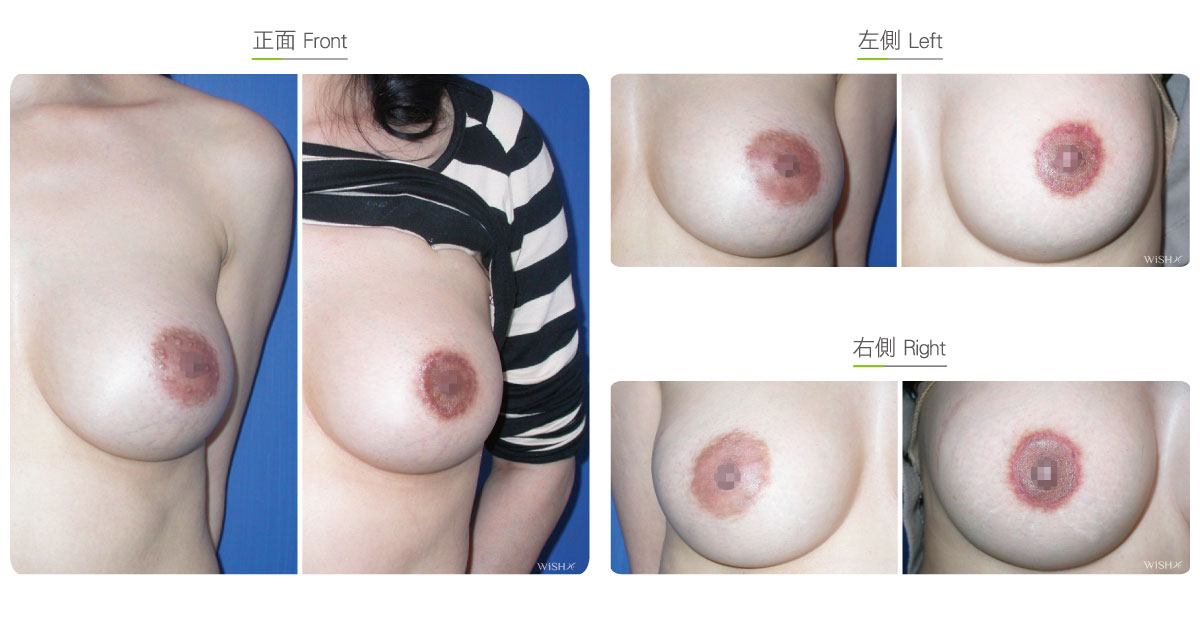Areolar Reduction
Asian women generally have more pigmented areolae, and if combined with large size, the overall esthetics of the breasts would be affected. Patients often seek plastic surgery to reduce the size of the areola. These problems are most commonly caused by wrinkled or loose areolar skin due to multiple pregnancies or repeated breastfeeding. A minority of problems are caused by genetics or breast hyperplasia (macromastia). Currently, there are two main surgeries to correct the large areolar problem:
- Nipple Base Incision
Some of the loose areolar skin at the crease between the areola and nipple is ablated and centripetally stitched back. This inner rim reduction is quick and easy, but it also leaves a white circular (donut-shaped) scar at the base of the nipple, which contrasts with the peripheral darker areola. In addition, the nipple could become deformed or flat due to overly tight stitches with the surrounding tissue. Because the main disadvantage is a limited degree of areolar reduction, Dr. Chuang normally does not recommend this procedure for patients with large areolae.
- Periareolar Incision
A part of the skin at the border of the areola is removed and centripetally stitched back. This outer rim reduction initially creates wrinkles in the peripheral areas next to the wound, but the skin spontaneously becomes flat in approximately 1–2 months. The biggest advantage is that the degree of excision is much more than that of nipple base ablation. It can not only blend the scar at the border of the areola and normal skin but also be combined with areolar breast lift, allowing more flexibility in operation. Because this surgery still creates a circular and light scar around the areola, careful care of the scar for 3–6 months postoperatively is essential.
Surgical conditions
Duration
0.5hr
- Type of anesthesia: IV sedation + local anesthesia
- Type of incision: Nipple base (inner rim reduction) or periareolar incision (outer rim reduction)
- Recovery: Immediate
- Removal of stitches: 10–14 days
General instructions
No food and water on the day of surgery
0hr
- Smoking and alcohol consumption should be avoided for 3 months postoperatively. The nipple should not be rubbed, and tight clothes that could compress the nipple should be avoided.
- Long-term wear of a supportive bra would be required to stabilize the breasts and to prevent the rubbing or hypertrophy of the nipple.
- Scar care should be continued for 3–6 months.
Ideal candidates
- Those with congenital hypertrophic areolae.
- Those with loose or wrinkled areolae due to pregnancy or breastfeeding.
- Those with increased areola size due to macromastia or breast ptosis.
- Those with asymmetric areola sizes.
- Those who need a periareolar breast lift.
Possible complications
- Hypertrophic scar
- Relapsed areola hypertrophy
- Flattened or deformed nipples
- Decreased nipple sensitivity
Surgical advantages
-
Effective reduction of the frontal areola size.
-
Periareolar incision can be combined with breast lift.
-
Can provide some improvement in cases where the areola is too dark.
-
Improvement of loose or wrinkled areolar skin.
Surgical drawbacks
-
Visible scars at the inner or outer rim of the areola.
-
Nipple base ablation could affect the projection and shape of the nipple.
-
The areolae could become larger again from breastfeeding, breast implants, or stimulation.
-
Possible decrease in nipple sensitivity.
Before & After
These photographs represent typical results, but not everyone who undergoes plastic surgery will achieve the same.


